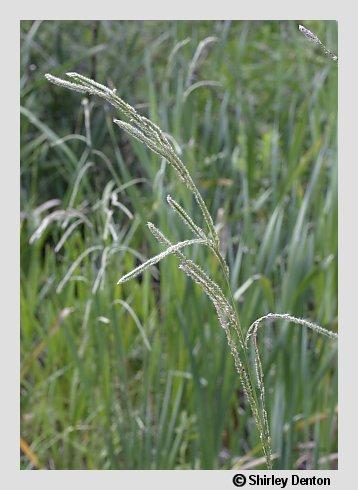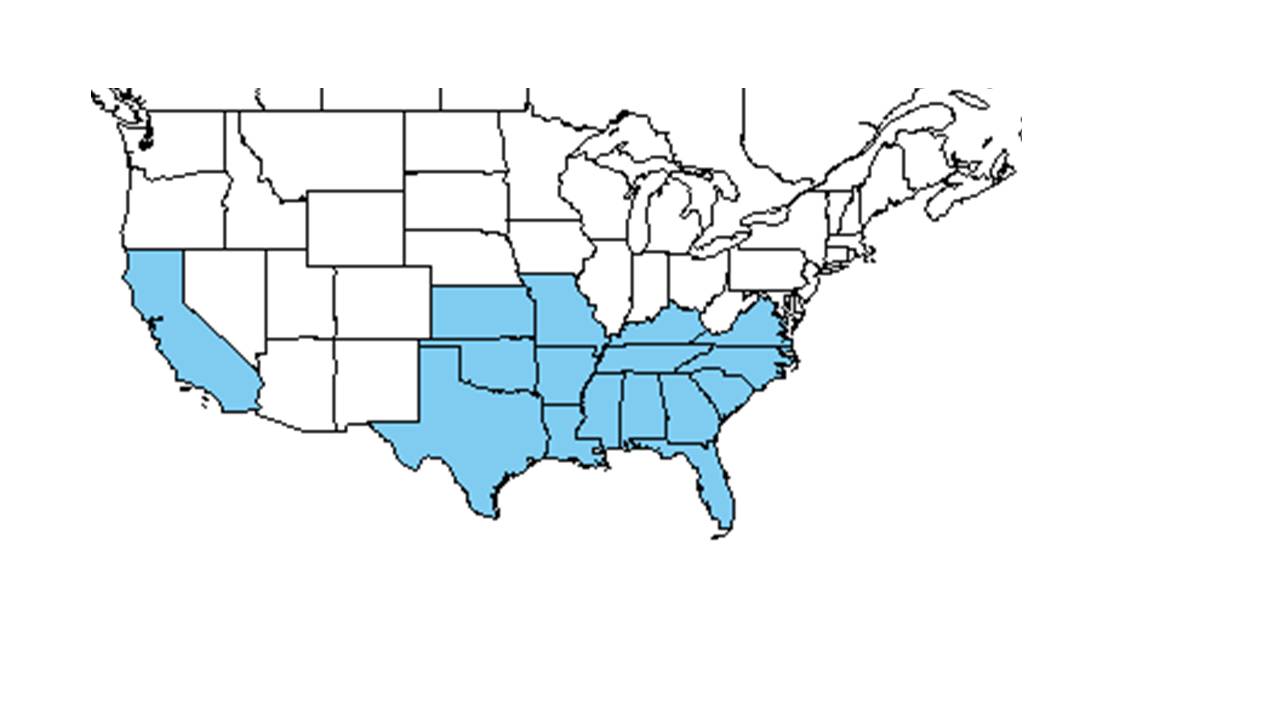Difference between revisions of "Paspalum urvillei"
Krobertson (talk | contribs) |
|||
| Line 26: | Line 26: | ||
==Ecology== | ==Ecology== | ||
===Habitat=== <!--Natural communities, human disturbed habitats, topography, hydrology, soils, light, fire regime requirements for removal of competition, etc.--> | ===Habitat=== <!--Natural communities, human disturbed habitats, topography, hydrology, soils, light, fire regime requirements for removal of competition, etc.--> | ||
| − | ''P. urvillei'' occurs mainly in moist sandy soil, but can be found in sandy loam, wet marshy areas, alluvial outwash, sand in shallow water, calcareous talus, wet peaty soil, white sand, and dry loamy clay | + | ''P. urvillei'' occurs mainly in moist sandy soil, but can be found in sandy loam, wet marshy areas, alluvial outwash, sand in shallow water, calcareous talus, wet peaty soil, white sand, and dry loamy clay. <ref name="FSU Herbarium">Florida State University Robert K. Godfrey Herbarium database. URL: [http://herbarium.bio.fsu.edu http://herbarium.bio.fsu.edu]. Last accessed: June 2014. Collectors: Loran C. Anderson, Robert K. Godfrey, Andre F. Clewell, R. A. Pursell, Bruce Hansen, R. E. Perdue, Jr., George M. Riegler, George R. Cooley, Richard J. Eaton, James D. Ray, Jr., Richard S. Mitchell, R. Kral, P. L. Redfearn, John B. Nelson, Cecil R Slaughter, Gary R. Knight, S. W. Leonard, William R. Stimson, R. Komarek, D. C. Hunt, R. F. Doren, and Richard R. Clinebell II. States and Counties: Florida: Baker, Broward, Calhoun, Clay, Columbia, Escambia, Flagler, Franklin, Gadsden, Gulf, Jackson, Jefferson, Lafayette, Leon, Liberty, Marion, Okaloosa, Orange, Pasco, Putnam, Seminole, St Johns, Union, Volusia, Wakulla, and Washington. Georgia: Grady and Thomas.</ref> It can occur in native communities, including pine flatwoods, thickets, marshy clearings in floodplain forests, and river bluffs, as well as bordering swamps, springs, and ponds. <ref name="FSU Herbarium"> However, it also occurs in disturbed areas, including roadsides, power line corridors, ditches, waste ground areas, vacant lots, cultivated ground, old fields, spoil banks, and construction sites. <ref name="FSU Herbarium"> |
===Phenology=== <!--Timing off flowering, fruiting, seed dispersal, and environmental triggers. Cite PanFlora website if appropriate: http://www.gilnelson.com/PanFlora/ --> | ===Phenology=== <!--Timing off flowering, fruiting, seed dispersal, and environmental triggers. Cite PanFlora website if appropriate: http://www.gilnelson.com/PanFlora/ --> | ||
| − | Flowering and fruiting has been observed in January, as well as in April through December | + | Flowering and fruiting has been observed in January, as well as in April through December. <ref name="FSU Herbarium"> |
<!--===Seed dispersal===--> | <!--===Seed dispersal===--> | ||
<!--===Seed bank and germination===--> | <!--===Seed bank and germination===--> | ||
===Fire ecology=== <!--Fire tolerance, fire dependence, adaptive fire responses--> | ===Fire ecology=== <!--Fire tolerance, fire dependence, adaptive fire responses--> | ||
| − | This species has been found in habitat that burns annually | + | This species has been found in habitat that burns annually. <ref name="FSU Herbarium"> |
<!--===Pollination===--> | <!--===Pollination===--> | ||
| Line 42: | Line 42: | ||
==Photo Gallery== | ==Photo Gallery== | ||
==References and notes== | ==References and notes== | ||
| − | |||
Revision as of 19:21, 4 August 2016
| Paspalum urvillei | |
|---|---|

| |
| Photo by Shirley Denton (Copyrighted, use by photographer’s permission only), Nature Photography by Shirley Denton | |
| Scientific classification | |
| Kingdom: | Plantae |
| Division: | Magnoliophyta - Flowering plants |
| Class: | Liliopsida – Monocotyledons |
| Order: | Cyperales |
| Family: | Poaceae ⁄ Gramineae |
| Genus: | Paspalum |
| Species: | P. urvillei |
| Binomial name | |
| Paspalum urvillei Steud. | |

| |
| Natural range of Paspalum urvillei from USDA NRCS Plants Database. | |
Common name: Vasey grass
Contents
Taxonomic notes
Description
Paspalum urvillei is a perennial graminoid species.
Distribution
Ecology
Habitat
P. urvillei occurs mainly in moist sandy soil, but can be found in sandy loam, wet marshy areas, alluvial outwash, sand in shallow water, calcareous talus, wet peaty soil, white sand, and dry loamy clay. [1] It can occur in native communities, including pine flatwoods, thickets, marshy clearings in floodplain forests, and river bluffs, as well as bordering swamps, springs, and ponds. <ref name="FSU Herbarium"> However, it also occurs in disturbed areas, including roadsides, power line corridors, ditches, waste ground areas, vacant lots, cultivated ground, old fields, spoil banks, and construction sites. <ref name="FSU Herbarium">
Phenology
Flowering and fruiting has been observed in January, as well as in April through December. <ref name="FSU Herbarium">
Fire ecology
This species has been found in habitat that burns annually. <ref name="FSU Herbarium">
Conservation and management
Cultivation and restoration
Photo Gallery
References and notes
- ↑ Florida State University Robert K. Godfrey Herbarium database. URL: http://herbarium.bio.fsu.edu. Last accessed: June 2014. Collectors: Loran C. Anderson, Robert K. Godfrey, Andre F. Clewell, R. A. Pursell, Bruce Hansen, R. E. Perdue, Jr., George M. Riegler, George R. Cooley, Richard J. Eaton, James D. Ray, Jr., Richard S. Mitchell, R. Kral, P. L. Redfearn, John B. Nelson, Cecil R Slaughter, Gary R. Knight, S. W. Leonard, William R. Stimson, R. Komarek, D. C. Hunt, R. F. Doren, and Richard R. Clinebell II. States and Counties: Florida: Baker, Broward, Calhoun, Clay, Columbia, Escambia, Flagler, Franklin, Gadsden, Gulf, Jackson, Jefferson, Lafayette, Leon, Liberty, Marion, Okaloosa, Orange, Pasco, Putnam, Seminole, St Johns, Union, Volusia, Wakulla, and Washington. Georgia: Grady and Thomas.